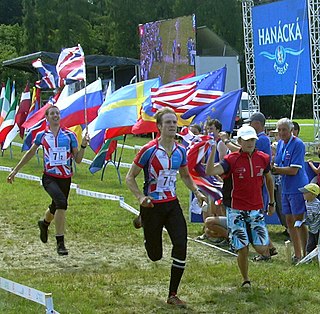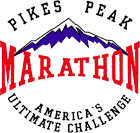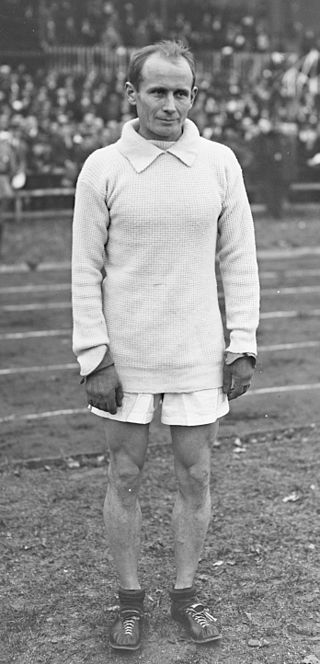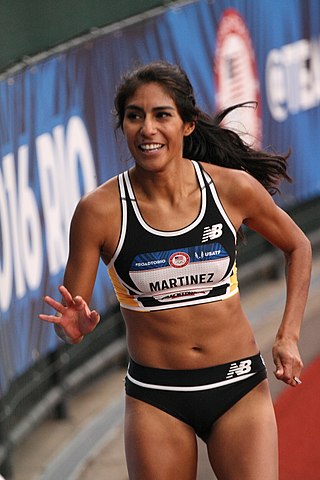Related Research Articles

The biathlon is a winter sport that combines cross-country skiing and rifle shooting. It is treated as a race, with contestants skiing through a cross-country trail whose distance is divided into shooting rounds. The shooting rounds are not timed per se, but depending on the competition, missed shots result in extra distance or time being added to the contestant's total.

A relay race is a racing competition where members of a team take turns completing parts of racecourse or performing a certain action. Relay races take the form of professional races and amateur games. Relay races are common in running, orienteering, swimming, cross-country skiing, biathlon, or ice skating. In the Olympic Games, there are several types of relay races that are part of track and field, each consisting of a set number of stages (legs), each leg run by different members of a team. The runner finishing one leg is usually required to pass the next runner a stick-like object known as a "baton" while both are running in a marked exchange zone. In most relays, team members cover equal distances: Olympic events for both men and women are the 400-metre and 1,600-metre relays. Some non-Olympic relays are held at distances of 800 m, 3,200 m, and 6,000 m. In the less frequently run medley relays, however, the athletes cover different distances in a prescribed order—as in a sprint medley of 200, 200, 400, 800 metres or a distance medley of 1,200, 400, 800, 1,600 metres.

Road running is the sport of running on a measured course over an established road. This differs from track and field on a regular track and cross country running over natural terrain.

The New York City Marathon, currently branded as the TCS New York City Marathon for sponsorship reasons, is an annual marathon that courses through the five boroughs of New York City. It is the largest marathon in the world, with 53,627 finishers in 2019 and 98,247 applicants for the 2017 race. Along with the Boston Marathon and Chicago Marathon, it is among the pre-eminent long-distance annual running events in the United States and is one of the World Marathon Majors.

The Pikes Peak Ascent and Marathon is a trail running competition that begins at the base of Pikes Peak, in Manitou Springs, Colorado, and climbs over 7,815 feet to the top of the 14,115 foot peak. Since 1956, the event takes place each year in late summer, with the Ascent taking place on Saturday, and the round-trip marathon on Sunday.

Ekiden (駅伝) is a long-distance running multi-stage relay race, mostly held on roads.

The Badwater Ultramarathon is a 135-mile (217 km) ultramarathon race starting at −282 feet (−86 m) below sea level in the Badwater Basin, in California's Death Valley, and ending at an elevation of 8,360 feet (2,550 m) at Whitney Portal, the trailhead to Mount Whitney. It takes place annually in mid-July when the weather is the most extreme and temperatures can reach 130 °F (54 °C) during the day at Badwater Basin.

Hood To Coast is a long distance relay race that starts at Mount Hood and continues nearly 200 miles to the Oregon Coast. Known as "the mother of all relays", it is the largest running and walking relay in the world, with 12,600 runners in the Hood To Coast relay and 19,000 total participants, including events like the Portland To Coast Walk. Founded in 1982, Hood To Coast is extremely popular and has filled its team limit for the past 36 years, most of the time on opening day of the entrance lottery.

The Great Lake Relay is an annual team running event over approximately 160 km. It is held at Taupō, New Zealand on the third Saturday of February. Each team consists of ten to eighteen members, either running or walking to complete the eighteen 4.7 km to 14.4 km legs around the largest lake in Australasia, Lake Taupō.

The men's marathon event was part of the track and field athletics programme at the 1920 Summer Olympics. The distance of this race was 42.75 kilometres. The competition was held on Sunday, 22 August 1920. 48 runners from 17 nations competed. No nation had more than 4 runners, suggesting the limit had been reduced from the 12 maximum in force in 1908 and 1912. The event was won by Hannes Kolehmainen of Finland, the nation's first Olympic marathon medal and victory; Kolehmainen received his fourth gold medal, having won the 5000 metres, 10,000 metres, and individual cross country in 1912. Estonia and Italy also won their first marathon medals.

Hakone Ekiden (箱根駅伝), officially called the Tokyo-Hakone Round Trip College Ekiden Race, is one of the most prominent university ekiden races of the year held between Tokyo and Hakone in Japan on January 2 and 3. The race is telecast on Nippon Television.
Lineth Chepkurui is a Kenyan long distance runner.
The River to River Relay is a long distance relay race in which teams of runners run from the Mississippi River to the Ohio River, covering a distance of 80 miles. Over 2000 runners take part in the race every year. River to River is a race of friendly competition that experienced to novice runners enjoy running. The race takes place in the southern part of Illinois beginning near Wolf Lake, Illinois and ending in Golconda, Illinois. The River to River Relay, the first of which was organized in 1987 with Gordon Pitz as the Race Director, is held annually sometime in April to not coincide with Easter weekend.

The Cabot Trail Relay Race is an annual 276.33 km (171.70 mi) relay race around Cape Breton's Cabot Trail. The race takes place over 24 hours in 17 stages and features up to 70 teams and 1,200 runners. The race begins and ends in Baddeck, Nova Scotia. The annual event began in 1988, when just 6 teams participated. Since its founding, over 27,000 runners have participated in the event.

The Ragnar Relay Series is a series of long distance running relay races. Teams of 6 to 12 runners run approximately 200 miles (320 km) over two days and one night. Founded in 2004, Ragnar hosts both road and trail relays across the United States and Canada. With 20 relays in different locations, the Ragnar Relay Series is the largest series of relays in the United States.

Brenda Martinez is an American middle-distance runner and Olympian. Born in Upland, California, she won a silver medal in the 800 meters at the 2013 IAAF World Championships in Moscow and finished first in the 800 meters at the 2014 Diamond League Final. She represented the US at the 2012 IAAF World Indoor Championships in the 1500 meters. Martinez twice set the world record in the Distance Medley Relay at the New Balance Indoor Grand Prix in Boston; first on February 7, 2015, and then breaking her own record on January 28, 2017. In 2016, Martinez qualified for the U.S. Olympic team competing in the 1500 meters after beating Amanda Eccleston by 0.03 seconds.

Ben Blankenship is an American middle distance runner. He is a world record holder as a member of the 2015 USA Distance medley relay team, of which he ran the 1600-meter anchor leg.

Weini Kelati Frezghi is an American middle and long distance runner. Born in Eritrea, she claimed asylum in the United States in July 2014 and subsequently achieved multiple victories in state and national level competitions while attending Heritage High School in Leesburg, Virginia. While competing for the University of New Mexico, Kelati won the 2019 NCAA Division I Cross Country Championships.

Shannon Osika is an American middle-distance runner specializing in the 1500 metres. She is a four-time outdoor and three-time indoor USA Championships finalist, and she was the silver medalist at the 2018 NACAC Championships. She briefly held the world record in the distance medley relay in 2022.
References
- ↑ 2007 Results
- ↑ 2008 Results
- ↑ "Archived copy". Archived from the original on 2010-10-16. Retrieved 2010-11-01.
{{cite web}}: CS1 maint: archived copy as title (link)